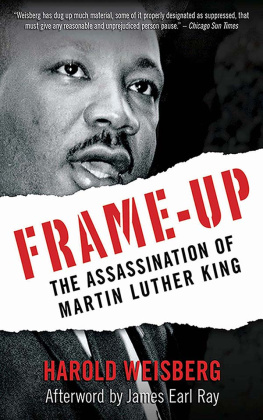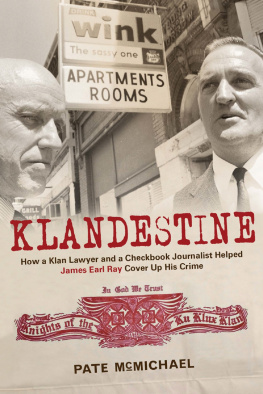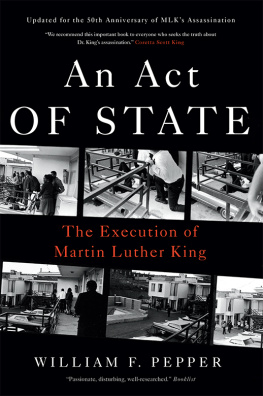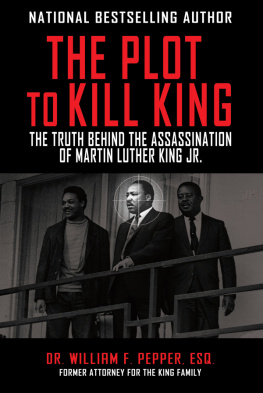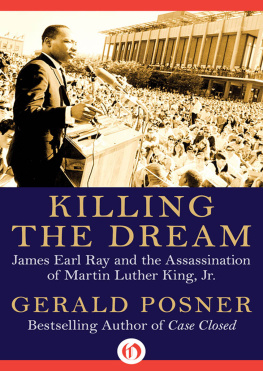The University Press of Mississippi is the scholarly publishing agency of the Mississippi Institutions of Higher Learning: Alcorn State University, Delta State University, Jackson State University, Mississippi State University, Mississippi University for Women, Mississippi Valley State University, University of Mississippi, and University of Southern Mississippi.
www.upress.state.ms.us
The University Press of Mississippi is a member of the Association of University Presses.
Copyright 1968, 1969, 1970, 1977 by William Bradford Huie.
Copyright 1998 by Martha Hunt Huie.
Reprinted with permission from Mary Ben Heflin.
Foreword and afterword 1997 by Wayne Greenhaw.
Reprinted with permission from Sally Greenhaw.
New foreword 2018 by Rich Richardson.
Publishing history: This book was first published in 1970 by Delacorte Press under the title He Slew the Dreamer. The book was republished in 1977 with a new prologue and epilogue by the author, under the title Did the FBI Kill Martin Luther King? by Thomas Nelson, Inc., Publishers. Another edition of the book titled, He Slew the Dreamer: My Search for the Truth about James Earl Ray and the Murder of Martin Luther King, was published in 1997 by Black Belt Press with permission from Martha Hunt Huie and included a new foreword and afterword by Wayne Greenhaw.
All rights reserved
Manufactured in the United States of America
UPM first printing 2018
Library of Congress Cataloging-in-Publication Data
Names: Huie, William Bradford, 19101986, author. | Greenhaw, Wayne, 1940 author of foreword and afterword. | Richardson, Rich, 1971 author of new foreword.
Title: He slew the dreamer: my search for the truth about James Earl Ray and the murder of Martin Luther King / William Bradford Huie; foreword and afterword by Wayne Greenhaw; new foreword by Rich Richardson.
Description: Jackson: University Press of Mississippi, [2018] | Includes bibliographical references and index. | Original version: New York, NY: Delacorte Press, 1970.
Identifiers: LCCN 2018037434| ISBN 9781496820624 (cloth) | ISBN 9781496820631 (pbk.) | ISBN 9781496820648 (epub single) | ISBN 9781496820655 (epub institutional) | ISBN 9781496820662 (pdf single) | ISBN 9781496820679 (pdf institutional)
Subjects: LCSH: King, Martin Luther, Jr., 19291968Assassination. | Ray, James Earl, 19281998. | LCGFT: True crime stories.
Classification: LCC HV6248.R39 H82 2018 | DDC 364.152/4092 [B] dc23 LC record available at
https://lccn.loc.gov/2018037434
British Library Cataloging-in-Publication Data available
And they said one to another, Behold, this dreamer cometh. Come now therefore, and let us slay him and we shall see what will become of his dreams.
GENESIS 37: 1920
(In Memphis, Tennessee, the motel room outside which Dr. King was slain has been converted into a shrine which is now a tourist attraction. On a wall at the spot where Dr. King fell is inscribed this quotation from Genesis. My title, He Slew the Dreamer, is derived from it.William Bradford Huie, 1970)
NEW FOREWORD
Rich Richardson
Though Dr. Martin Luther King, Jr., made world-changing contributions during his life and continues to influence many through his legacy, uncertainty, mystery, and unanswered questions still linger a half century after his death in Memphis, Tennessee on April 4, 1968. After all these years, suspicions that there was a government conspiracy to take his life, which began to proliferate after his death on the balcony at the Lorraine Motel, still loom large among many, including Dr. Kings family. Dr. Kings younger son Dexter King met with James Earl Ray, his fathers alleged assassin serving a ninety-nine year sentence at a Nashville prison for the murder, in the months before Rays death. By then, he no longer believed that Ray was the one who assassinated Dr. King. During this meeting, the media highlighted video of Dexter on March 27, 1997 shaking the hand of his fathers alleged assassin, who denied that he killed the leader.
To be sure, a conspiracy seems plausible when considering the political climate during the 1960s. The era was shadowed by multiple high-profile assassinations linked to conspiracy, including the deaths of President John F. Kennedy, Senator Robert Kennedy, and Nation of Islam leader Malcolm X. It was a period during which many leaders in the black liberation movement were being surveilled. Organizations with which they were affiliated were infiltrated and deliberately destabilized by imposters working under the auspices of the counter-intelligence program known as COINTELPRO, carried out by the Federal Bureau of Investigation led by J. Edgar Hoover. In some instances, black leaders were targeted and assassinated through state-sanctioned violence, as was the case in the deaths of Black Panther Party members Fred Hampton and Mark Clark at the hands of the Chicago police in 1969. Only in the years after his death and when this program was exposed to the public did the magnitude of the surveillance to which Dr. King was subjected by the FBI become clear, to
William Bradford Huie had been dead for ten years by the time that Dexter Kings encounter with Ray occurred. The book on the case that he left behind, which included exhaustive interviews with Ray, initially pondered conspiracy, but concluded that Ray, whom Huie suggested had a criminal identity and was obsessed with building his criminal profile, was guilty and acted alone in killing King because he wanted to gain notoriety among the FBIs Top Ten. Huie kept an open mind from the beginning of his investigation and did not rule out the possibility of conspiracy, though he found no convincing evidence for it in the end. Although it was not his own motive for disavowing it, he explains that conspiracy was downplayed in the official stories about the assassination that circulated in the media because of the volatility of cities in the US in the aftermath and to facilitate Rays extradition from London for trial. Significantly, he also acknowledges that notions of conspiracy served the interests of racists eager to see Ray exonerated.
In the months after the murder, Huie, who knew Dr. King and regarded him as a friend, did pioneering investigative work on the assassination through an exhaustive probe into the experiences, movements, contacts, travels and transactions of Kings alleged assassin, who had escaped from the Missouri State Penitentiary in 1967. In many instances, Huie retraced the steps that Ray had made in the months prior to the assassination to Mexico, Canada, in the US and in Europe, paid some investigators to do this tracking in some cases, and also interviewed and corresponded with him in an effort to get at the truth of what happened and why. (Huie tried to retrace all of Rays movements. Huie personally researched/retraced most of what Ray described, but also paid a few capable investigators to help with pieces of the research as Ray went to multiple foreign countries and traveled across the US.) He followed it up with a new edition under the title


